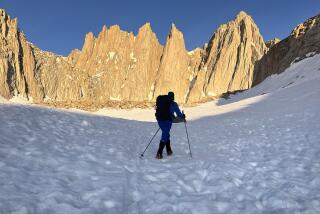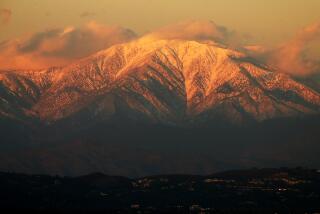Admitting an Error Because It Is There
- Share via
“Please correct me if I’m wrong,” writes Joseph R. Goldstein of Encino. “I always thought it was George Herbert (Leigh) Mallory, not Sir Edmund Hillary, who is credited with ‘Because it is there.’ ”
Dr. Goldstein is not wrong. I was guilty of a common error in misattributing Mallory’s heroically terse explanation of why he tried to climb Mt. Everest to the more celebrated Hillary, who did.
Bruce Nolte of Pasadena also corrects me, noting that the error is made by “many, many people.” H. P. Amacker of Santa Monica protests that Mallory was one of his boyhood idols--”the quintessential noble failure, famous for his courage . . . not for his accomplishments. Hillary has honors enough without being credited with Mallory’s mot juste .”
Oddly, despite his three assaults on the world’s highest peak (28,028 feet) in the 1920s, failures that helped later climbers, Mallory is not even listed in the Encyclopaedia Britannica.
He was part of a British team that challenged the mountain in 1921, but was stopped at 22,916 feet by devastating winds. Mallory wrote: “It would have been folly to go on. . . .”
In a 1922 assault two British climbers reached 27,300 feet--the highest point ever reached by man--but the expedition ended tragically when seven Sherpa porters died in an avalanche.
Mallory blamed himself for the accident. He wrote his wife: “The consequences of my mistake are so terrible; it seems almost impossible to believe that it has happened for ever and that I can do nothing to make good. There is no obligation I have so much wanted to honor as that of taking care of those men.”
Financially out on a limb, with no job and a wife and family to support, Mallory went on a speaking tour of the United States. It was after one of his lectures that a reporter asked him why he had climbed the mountain.
Mallory replied, “Because it is there”--”a phrase,” according to Walt Unsworth in “Everest: A Mountaineering History,” “which has passed out of the realm of mountaineering history into common usage.”
He asks: “What did Mallory mean? Part of the phrase’s popularity is undoubtedly its enigmatic quality, but it must have meant something to Mallory, at least. Was it, as some of his closest friends claimed, just the irritable reply of a tired lecturer to a question he had heard a thousand times before? If so, it was an unconscious flash of genius.”
Unsworth argues that Mallory had often used the word there to indicate a mystical quality. “To him the word there seems to have gained an all-embracing meaning for mystical feeling which he could not put exactly into words--and this certainly applied to the climbing of Mount Everest.”
Unsworth suggests that Mallory may have been searching for what the poet Franz Werfel put more elegantly: “For those who believe, no explanation is necessary; for those who do not believe, no explanation is possible.”
Micheline Morin writes in “Everest: From the First Attempt to the Final Victory,” that there has always been a great deal of argument over what drives men to climb mountains. “The best reason of all was given by Mallory--a simple reason, but one that includes all the others. . . . ‘Because it’s there.’ ” (I tend to doubt that Mallory used the contraction.)
Some historians have taken a more cynical view of Mallory’s remark. In “Great Ascents,” Eric Newby says he can’t hazard a guess as to why men climb mountains. “ ‘Because it is there,’ Mallory’s dictum, always seemed rather barren and slightly brittle in the idiom of (Noel) Coward: ‘Did you like the Himalayas? Liked him, hated her.’ ”
Trying once again in 1924, Mallory and a fellow climber, Andrew Irvine, set out on the final assault, hoping to reach the top. They were never seen again. Some believe they may have reached the summit and frozen to death on their descent.
Just before the expedition sailed, Mallory had said to a friend: “This is going to be more like war than mountaineering. I don’t expect to come back.” To his wife he had written: “I can’t see myself coming down defeated.”
Twenty-nine years later, when Hillary and his Nepalese comrade Tenzing Norgay reached the summit, they looked for signs of Mallory and Irvine’s presence there, but found nothing.
More to Read
Sign up for The Wild
We’ll help you find the best places to hike, bike and run, as well as the perfect silent spots for meditation and yoga.
You may occasionally receive promotional content from the Los Angeles Times.






